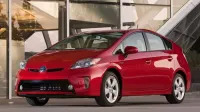Hybrids lead fastest growing segment but still may not be worth the extra price

First-quarter electric-drive vehicle sales jumped 49 percent from a year earlier to more than 117,000 vehicles, according to Bloomberg Businessweek. With such growth – both the Chevrolet Volt extended-range plug-in hybrid and the Toyota Prius hybrid set monthly sales records in March – GM cut its previously planned production shutdown from four weeks to five and Nissan CEO Carlos Ghosn said Nissan Leaf battery-electric vehicle sales could grow further starting later this year once U.S. production of the car get underway. Domestic production might also lowering the EVs cost in America.
Last month, sales of hybrids, plug-ins and diesels rose almost 40 percent. In addition to the Prius and Volt, sales of the Nissan Leaf, Volkswagen diesels and General Motors’ eAssist-powered mild hybrids such as the Buick LaCrosse and Chevy Malibu also jumped substantially.
The growth rate likely reflects the effect of both rising gas prices and year-earlier supply constraints on models such as the Prius stemming from the earthquake and tsunami that struck Japan last March. Regular gas prices are approaching $4 a gallon, up about 60 cents this year, according to AAA.
Still, most hybrids would take more than a decade to pay off their higher costs in the form of lower refueling expenses, and that scenario wouldn’t change even if gas prices were to rise to $5 a gallon, the New York Times reports, using data compiled by automotive research website TrueCar.com.
The Times says models such as the Prius and the Lincoln MKZ Hybrid pay back their owners within two years, but a car like the Ford Fusion Hybrid takes more than eight years to pay off at $4 a gallon and 15,000 miles a year driven. And even with gas prices at $6 a gallon, hybrid versions of the Toyota Camry Hybrid, Kia Optima and Hyundai Sonata would still take four years to pay off. Even with gas at $5 a gallon, a Nissan Leaf would take nine years to pay off the difference between is price and that of the Nissan Versa. Relative to the Chevy Cruze, the Volt could take a quarter-century to pay off.
We wondered about those numbers. The only comparisons that can honestly be made are between cars that have ICE-only and hybrid versions. So we did some math. The 2.5-liter I4 Fusion gets 25 miles per gallon combined and costs $24,970. Thus, fuel for 15,000 miles at $4.00 would be $2,400. The Fusion Hybrid gets 39 mpg combined and costs $29,570. Fuel for 15,000 miles in this car would be $1,538. So, the difference per year is $862. Given this, the Hybrid would pay back the initial price difference of $4,600 in 5.3 years, not eight. Of course, if you compare either of the more expensive and thirstier V6 versions, the numbers are even more favorable (2.8 years for the 3.0 V6, for example).
Perhaps buyers are driven by something other than payback times, like simply using less fuel. Whatever the reason, some lower-priced hybrids seem to be making a case that the extra price is worth it. For example, there were more Toyota Prius C compacts sold within its first three days on the market in March than Nissan Leaf battery-electric vehicles and Chevrolet Volt extended-range plug-ins in all of February.




